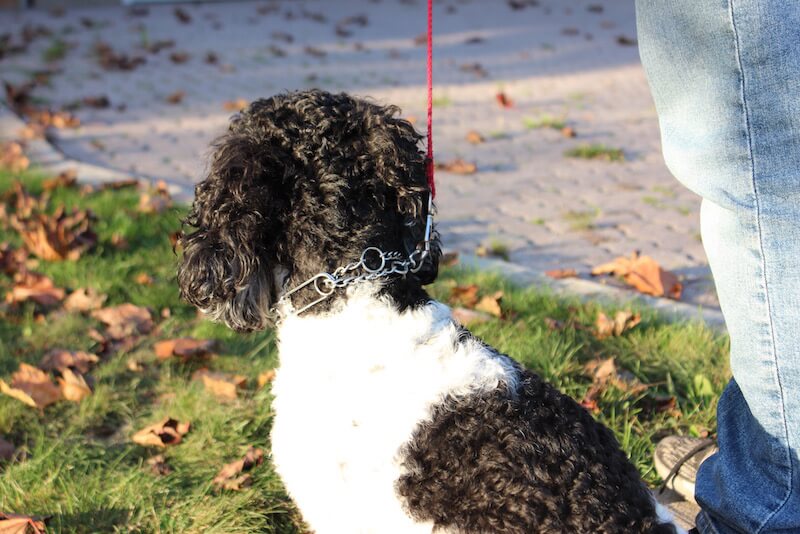Stranger Aggression and Separation Anxiety
by Anne
(UK)

From Anne... Meah is a 5 year old Pointer. We adopted her in October 2013 from a rescue centre. She had been used for breeding in Ireland and when no longer useful was taken in by the rescue centre. She was very skinny and nervous when we took her in. She is very sweet natured and very gentle indoors. She has gained weight and is now at optimum weight.
She is whistle trained but will cower if anything is lifted above her head as if she has been hit. When we first got her she was very hand shy and cowered or turned away from a hand if we went to stroke her.
She will not eat her food until I turn away from it when I've put it down for her and she didn't understand what a treat was at first. She now enjoys her treats and knows to expect one after we come in from a walk but is very gentle when she takes it from me.
If we give her a bone she will let us take it from her without any problem at all. She is fine with the family now and we can check her feet and hold her head and fuss her. She also now plays with toys.
She has bonded with everyone in the family and shows no aggression to friends/family when they enter the house. She will bark and growl at noises of passing cars, the postman, etc, but once someone enters the property and is greeted by us, she wags her tail to greet them. We think she is very submissive of us and knows that she is at the bottom of the pack.
However, if out in public she is very well behaved but has started to growl or show her teeth at strangers if they come over to us and put their hand to her to stroke her. Also we cannot leave her alone in the house as she tries to escape. If she gets out she merely sits in the drive to wait for us to get home but causes damage to the house and obviously is very distressed at being left alone.
So we have 2 areas that we need help with. The aggression she shows to strangers when we are out with her and separation anxiety.
We'll be very grateful for any advice you can give for these two issues... we are desperate to resolve as we love Meah to bits.
Many Thanks, Anne
Shannon Says...

Hi Anne,
Meah is a beautiful Pointer! It sounds like you have come a long way with her since bringing her into your home.
Dogs who have been neglected or abused in some way definitely need a lot of patience and extra work to help them over their fears.
Separation Anxiety - Solutions
I'll start with the separation anxiety. This behavior is pretty common with dogs who have lived in shelters for a period of time, or dogs who've been abused.
The best thing you can do is take time to crate train Meah properly. I don't ever use a crate for punishment, but instead, it becomes your dog's safe place. I have an article about how to crate train that will be helpful.
With a dog who suffers from separation anxiety, it may take a little longer for her to be completely comfortable in a crate. Take your time, and don't ever force her into the crate. Instead, always make it a happy environment - toss her favorite treat in while saying "Kennel" in an upbeat tone of voice, and then let her go in on her own. Don't close the door right away, either, but let her come out again. Repeat this often.
Once this is going well, repeat but this time close the door for a few seconds after she is inside. Make sure she is quiet when you open the door, so she doesn't learn that barking or whining will get her out.
Slowly increase the length of time in 5 minute increments that she spends in her crate while you are home. Put the crate in a central location of the house, where she'll be able to hear you moving about. It will help to give her a chew toy or kong with some peanut butter inside of it to keep her busy and in a calm state of mind.
As she becomes more relaxed with the crate, you can start having her go in the crate with a toy to chew, and then working on some desensitization. Most dogs will have "triggers" to anxiety. For example, Meah might start panting or whining when you pick up your keys or put your jacket on.
So once she's calmly in her crate, pick up your keys and carry them with you as you move around the house. Jingle them a little, too! Eventually, she won't react to this as she sees that it doesn't mean that you will leave her. Do the same thing with putting your jacket or shoes on. Remember, only let her out of the crate when she is calm!
I recommend getting a plastic Vari Kennel instead of a wire crate if possible. Dogs tend to feel safer in closed in kennels, as they are more "den-like". You can put a blanket in there to make it more comfortable, too.
Stranger Aggression
As for aggression, you need to correct her when she growls, barks, or shows any aggression to a stranger. By correction, I mean a firm, quick pop on the leash, as this is much more effective than saying "no".
So say nothing while you correct - actions speak louder than words! The second she stops that behavior, give her a little praise.
When walking her, it's a good idea to train her to heel beside you on leash, as this reinforces that you are in control of the walk and how to respond to people that you meet.
Make sure her collar is positioned up high on her neck, as this is the most effective way to correct (very little muscle here).
What will help with this as well is to socialize her as much as you can. Take her to new places and environments, and let her see as many new people as possible. As she is already a little hand shy, ask people not to pet her.
Instead, have them hold a treat in their palm for her to smell them as she eats it, and then if she is calm, they can scratch her under the chin. Having a new person try to pet her on her head from above can be seen as a threat, so she is likely showing fear aggression.
I hope this is helpful to you, and wish you all the best in working with Meah.


